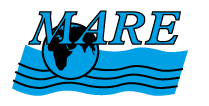A program of the Lawrence Hall of Science that seeks to increase ocean literacy through informal and formal education initiatives
Discovery of Sound in the Sea
Oceanographers, submariners, whales, dolphins, seals, in short, all working or living in the ocean use sound to sense their surroundings, to communicate, and to navigate. This web site will introduce you to the science and uses of Sound in the Sea. Resources include animal sound galleries, K-12 instructional curriculum and information on the technology used to explore the ocean realm.
Teacher and Kids Sites for the Ocean
NOAA's Year of the Ocean campaign has gathered a number of great links for teachers and kids covering a wide range of marine science-related topics.
Biomes of the World
This web site provides a kid-friendly overview of several different marine and fresh water habitats. There is information on organisms living within the habitat as well as special features that define the habitat.
Basic Fish Facts
Really basic fish facts for kids.
Ocean Link
OceanLink is dedicated to ocean education. Throughout these pages, you will find all kinds of interesting information about things like: the biggest sea animals, marine biology careers, answers to common ocean/animal questions, and much more!! This page is teacher and student-friendly.
Image Quest Marine Images
Looking for a great image of a marine organism? From the dark abyss to the sunlit surface waters, Image Quest 3-D's picture library, PELAGICA, proactively documents and illustrates the inhabitants of the marine realm, with particular emphasis upon the intriguing planktonic communities of the open oceans and the bizarre inhabitants of the great ocean depths. These pictures are phenomenal!
Tides and Tide Predictions
A great website for explaining how tides are predicted around the world. This site also has links to other tidal prediction websites for tidal information worldwide.
Shallow Subtidal Page from SUNY Stony Brook
Between the seashore and the open ocean is a shallow area called the subtidal zone. This site is loaded with great images of creatures you might find near shore or slightly farther out. One picture even shows the different shapes of radular teeth snails have depending on what they eat.
National Marine Educator's Association
The National Marine Educators Association (NMEA) brings together those interested in the study and enjoyment of the world of water--both fresh and salt. NMEA provides a valuable focus for marine and aquatic studies world-wide. We include professionals in:
* Education
* Science
* Business
* Government
* Museums
* Aquariums
* Marine Research
Centers for Ocean Sciences Education Excellence (COSEE)
The ten Centers for Ocean Sciences Education Excellence (COSEE) promote partnerships between research scientists and educators, disseminate best practices in ocean sciences education and promote ocean education as a charismatic, interdisciplinary vehicle for creating a more scientifically literate workforce and citizenry.
Pages




